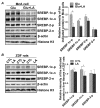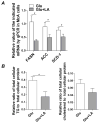Activation of hepatic CREBH and Insig signaling in the anti-hypertriglyceridemic mechanism of R-α-lipoic acid
- PMID: 26007286
- PMCID: PMC4547883
- DOI: 10.1016/j.jnutbio.2015.03.011
Activation of hepatic CREBH and Insig signaling in the anti-hypertriglyceridemic mechanism of R-α-lipoic acid
Abstract
The activation of sterol regulatory element binding proteins (SREBPs) is regulated by insulin-induced genes 1 and 2 (Insig-1 and Insig-2) and SCAP. We previously reported that feeding R-α-lipoic acid (LA) to Zucker diabetic fatty (ZDF) rats improves severe hypertriglyceridemia. In this study, we investigated the role of cyclic AMP-responsive element binding protein H (CREBH) in the lipid-lowering mechanism of LA and its involvement in the SREBP-1c and Insig pathway. Incubation of McA cells with LA (0.2 mM) or glucose (6 mM) stimulated activation of CREBH. LA treatment further induced mRNA expression of Insig-1 and Insig-2a, but not Insig-2b, in glucose-treated cells. In vivo, feeding LA to obesity-induced hyperlipidemic ZDF rats activated hepatic CREBH and stimulated transcription and translation of Insig-1 and Insig-2a. Activation of CREBH and Insigs induced by LA suppressed processing of SREBP-1c precursor into nuclear SREBP-1c, which subsequently inhibited expression of genes involved in fatty acid synthesis, including FASN, ACC and SCD-1, and reduced triglyceride (TG) contents in both glucose-treated cells and ZDF rat livers. Additionally, LA treatment also decreased abundances of very low density lipoprotein (VLDL)-associated apolipoproteins, apoB100 and apoE, in glucose-treated cells and livers of ZDF rats, leading to decreased secretion of VLDL and improvement of hypertriglyceridemia. This study unveils a novel molecular mechanism whereby LA lowers TG via activation of hepatic CREBH and increased expression of Insig-1 and Insig-2a to inhibit de novo lipogenesis and VLDL secretion. These findings provide novel insight into the therapeutic potential of LA as an anti-hypertriglyceridemia dietary molecule.
Keywords: Apolipoproteins; Cell signaling; Dyslipidemias; Sterol regulatory element binding proteins; Triglyceride metabolism; Very low density lipoprotein.
Copyright © 2015 Elsevier Inc. All rights reserved.
Conflict of interest statement
The authors declare that there are no conflicts of interest.
Figures





Similar articles
-
Glucagon regulates hepatic lipid metabolism via cAMP and Insig-2 signaling: implication for the pathogenesis of hypertriglyceridemia and hepatic steatosis.Sci Rep. 2016 Sep 1;6:32246. doi: 10.1038/srep32246. Sci Rep. 2016. PMID: 27582413 Free PMC article.
-
Insulin enhances the biogenesis of nuclear sterol regulatory element-binding protein (SREBP)-1c by posttranscriptional down-regulation of Insig-2A and its dissociation from SREBP cleavage-activating protein (SCAP).SREBP-1c complex.J Biol Chem. 2009 Nov 13;284(46):31726-34. doi: 10.1074/jbc.M109.050914. Epub 2009 Sep 16. J Biol Chem. 2009. PMID: 19759400 Free PMC article.
-
Overexpression of Insig-1 protects β cell against glucolipotoxicity via SREBP-1c.J Biomed Sci. 2011 Aug 16;18(1):57. doi: 10.1186/1423-0127-18-57. J Biomed Sci. 2011. PMID: 21843373 Free PMC article.
-
Insulin-induced gene: a new regulator in lipid metabolism.Peptides. 2010 Nov;31(11):2145-50. doi: 10.1016/j.peptides.2010.07.020. Epub 2010 Sep 15. Peptides. 2010. PMID: 20817058 Review.
-
CREBH Regulates Systemic Glucose and Lipid Metabolism.Int J Mol Sci. 2018 May 8;19(5):1396. doi: 10.3390/ijms19051396. Int J Mol Sci. 2018. PMID: 29738435 Free PMC article. Review.
Cited by
-
Lipoic acid in metabolic dysfunction-associated steatotic liver disease: a review.Nutr Metab (Lond). 2025 Jun 7;22(1):56. doi: 10.1186/s12986-025-00954-9. Nutr Metab (Lond). 2025. PMID: 40483465 Free PMC article. Review.
-
An acetyl-L-carnitine switch on mitochondrial dysfunction and rescue in the metabolomics study on aluminum oxide nanoparticles.Part Fibre Toxicol. 2016 Jan 16;13:4. doi: 10.1186/s12989-016-0115-y. Part Fibre Toxicol. 2016. PMID: 26772537 Free PMC article.
-
Glucagon regulates hepatic lipid metabolism via cAMP and Insig-2 signaling: implication for the pathogenesis of hypertriglyceridemia and hepatic steatosis.Sci Rep. 2016 Sep 1;6:32246. doi: 10.1038/srep32246. Sci Rep. 2016. PMID: 27582413 Free PMC article.
-
R-α-Lipoic Acid and 4-Phenylbutyric Acid Have Distinct Hypolipidemic Mechanisms in Hepatic Cells.Biomedicines. 2020 Aug 15;8(8):289. doi: 10.3390/biomedicines8080289. Biomedicines. 2020. PMID: 32824248 Free PMC article.
References
-
- Ginsberg HN, Zhang YL, Hernandez-Ono A. Metabolic syndrome: Focus on dyslipidemia. Obesity. 2006;14:41s–9s. - PubMed
-
- Ron D, Walter P. Signal integration in the endoplasmic reticulum unfolded protein response. Nat Rev Mol Cell Biol. 2007;8:519–29. - PubMed
-
- Asada R, Kanemoto S, Kondo S, Saito A, Imaizumi K. The signalling from endoplasmic reticulum-resident bZIP transcription factors involved in diverse cellular physiology. J Biochem. 2011;149:507–18. - PubMed
-
- Yamamoto K, Sato T, Matsui T, Sato M, Okada T, Yoshida H, et al. Transcriptional induction of mammalian ER quality control proteins is mediated by single or combined action of ATF6alpha and XBP1. Dev Cell. 2007;13:365–76. - PubMed
-
- Bailey D, O’Hare P. Transmembrane bZIP transcription factors in ER stress signaling and the unfolded protein response. Antioxid Redox Signal. 2007;9:2305–21. - PubMed
Publication types
MeSH terms
Substances
Grants and funding
LinkOut - more resources
Full Text Sources
Other Literature Sources
Medical
Molecular Biology Databases
Miscellaneous

